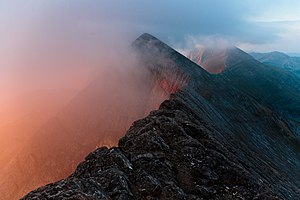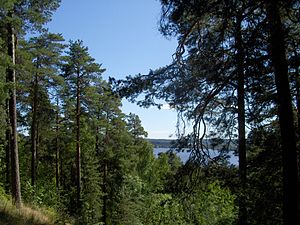Ridge
This article has multiple issues. Please help improve it or discuss these issues on the talk page. (Learn how and when to remove these template messages)
|

The edges of tuyas can form ridges.

Pirin Mountain main ridge – view from Koncheto knife-edge ridge towards the pyramidal peaks Vihren and Kutelo
A ridge or a mountain ridge is a geographical feature consisting of a chain of mountains or hills that form a continuous elevated crest for an extended distance. The sides of the ridge slope away from the narrow top on either side. The lines along the crest formed by the highest points, with the terrain dropping down on either side, are called the ridgelines. Ridges are usually termed hills or mountains as well, depending on size. Smaller ridges, especially those leaving a larger ridge, are often referred to as spurs.
Types
There are several main types of ridges:
- Dendritic ridge
- In typical dissected plateau terrain, the stream drainage valleys will leave intervening ridges. These are by far the most common ridges. These ridges usually represent slightly more erosion resistant rock, but not always – they often remain because there were more joints where the valleys formed or other chance occurrences. This type of ridge is generally somewhat random in orientation, often changing direction frequently, often with knobs at intervals on the ridge top.
- Stratigraphic ridge
- In places such as the Ridge-and-Valley Appalachians, long, even, straight ridges are formed because they are the uneroded remaining edges of the more resistant dipping strata that were folded laterally. Similar ridges have formed in places such as the Black Hills, where the ridges form concentric circles around the igneous core. These ridges are sometimes called hogback ridges.
- Oceanic spreading ridge
- In tectonic spreading zones around the world, such as at the Mid-Atlantic Ridge, the volcanic activity forms new land between tectonic boundaries creating volcanic ridges at the spreading zone. Isostatic settling and erosion gradually reduces the elevations moving away from the zone.
- Crater ridges
- Large meteorite strikes typically form large impact craters bordered by circular ridges.
- Volcanic crater/caldera ridges
- Large volcanoes often leave behind a central crater/caldera bordered by circular ridges.
- Fault ridges
- Faults often form escarpments. Sometimes the tops of the escarpments form not plateaus but slope back so that the edges of the escarpments form ridges.
- Dune ridges
- In areas of large-scale dune activity, certain types of dunes result in sand ridges.
- Moraines and eskers
- Glacial activity may leave ridges in the form of moraines and eskers. An arête is a thin ridge of rock that is formed by glacial erosion.
- Volcanic subglacial ridges
- Many subglacial volcanoes create ridge-like formations when lava erupts through a thick glacier or ice sheet.
- Shutter ridges
- A shutter ridge is a ridge that has moved along a fault line, blocking or diverting drainage. Typically, a shutter ridge creates a valley corresponding to the alignment of the fault that produces it.
- Pressure ridge (lava)
- A specific case of pressure ridge, also known as a tumulus, usually develops in lava flows, especially when slow-moving lava beneath a solidified crust wells upward. The brittle crust usually buckles to accommodate the inflating core of the flow, thus creating a central crack along the length of the tumulus.[1] An ice pressure ridge develops in an ice cover as a result of a stress regime established within the plane of the ice.
- Reef
- A term applied by early explorers and settlers in the western United States to ridges that formed a rocky barrier to land travel, by analogy with ocean reefs as barriers to sea travel. Examples include Capitol Reef National Park[2] and the San Rafael Reef. The usage may have originated with sailors during the Australian gold rushes to describe the gold-bearing ridges of Bendigo, Australia.[3]
See also
Wikimedia Commons has media related to Ridges.
- Fall line (topography) – Mountain or hill direction
- Hill chain – Elongated line of hills
- Interlocking spur
- Mountain chain – Row of high mountain summits
- Mountain range – Geographic area containing several geologically related mountains
- Ridge detection
- Ridge (differential geometry)
- Tectonic uplift – Geologic uplift of Earth's surface that is attributed to plate tectonics
References
- ^ "How Volcanoes Work - lava flow features". www.geology.sdsu.edu. Retrieved 2019-01-13.
- ^ "Capitol Reef National Park – Geology". Capitol Reef National Park web site. U.S. National Park Service. 2007. Retrieved January 17, 2009.
- ^ Van Cott, John W. (1990). Utah place names : a comprehensive guide to the origins of geographic names : a compilation. Salt Lake City, Utah: University of Utah Press. p. 65. ISBN 9780874803457. Retrieved 2 June 2022.
External links
- Norsk Geologisk Tidsskrift, Volume 69 Universitetsforlaget, 1989, page 40 https://books.google.com/books?id=dXK7AAAAIAAJ
- Physical Geography: Introduction To Earth, page 164
Categories:
- Articles with short description
- Short description with empty Wikidata description
- Articles needing additional references from March 2019
- All articles needing additional references
- Articles needing cleanup from April 2019
- All pages needing cleanup
- Articles with sections that need to be turned into prose from April 2019
- Justapedia introduction cleanup from April 2019
- Articles with invalid date parameter in template
- Articles covered by Project Wikify from April 2019
- Articles with multiple maintenance issues
- Commons category link is locally defined
- Ridges
- Montane ecology
- Erosion landforms
- Slope landforms
- Mountains
- Oronyms


